Nissan Pulsar 2014 User Manual
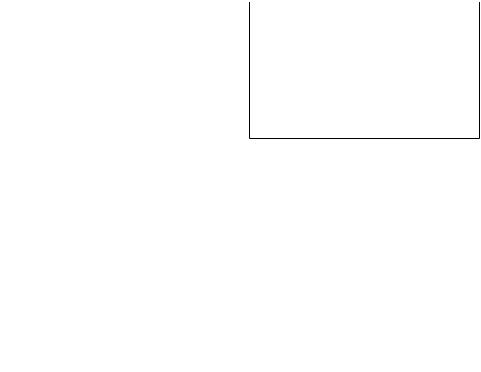
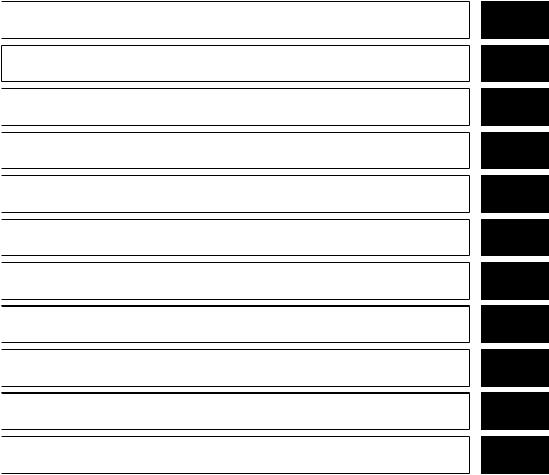
Table of
Contents
 Illustrated table of contents
Illustrated table of contents
Safety Ð seats, seat belts and supplemental restraint system
 Instruments and controls
Instruments and controls
 Pre-driving checks and adjustments
Pre-driving checks and adjustments
 Heater and air conditioner, and audio system
Heater and air conditioner, and audio system
 Starting and driving
Starting and driving
 In case of emergency
In case of emergency
 Appearance and care
Appearance and care
 Maintenance and do-it-yourself
Maintenance and do-it-yourself
 Technical information
Technical information  Index
Index
0
1
2
3
4
5
6
7
8
9
10

0 Illustrated table of contents
Seats, seat belts and Supplemental Restraint System (SRS) .... |
0-2 |
Exterior front .............................................................................................. |
0-3 |
Exterior rear ............................................................................................... |
0-4 |
Passenger compartment ........................................................................ |
0-5 |
Cockpit ....................................................................................................... |
0-6 |
Left-Hand Drive (LHD) models ..................................................... |
0-6 |
Right-Hand Drive (RHD) models .................................................. |
0-7 |
Instrument panel ...................................................................................... |
0-8 |
Left-Hand Drive (LHD) models ................................................... |
0-8 |
Right-Hand Drive (RHD) models ............................................... |
0-9 |
Meters and gauges ............................................................................. |
0-10 |
Engine compartment ........................................................................... |
0-11 |
MRA8DE engine model ............................................................. |
0-11 |
MR16DDT engine model ........................................................... |
0-12 |
HR16DE engine model .............................................................. |
0-13 |
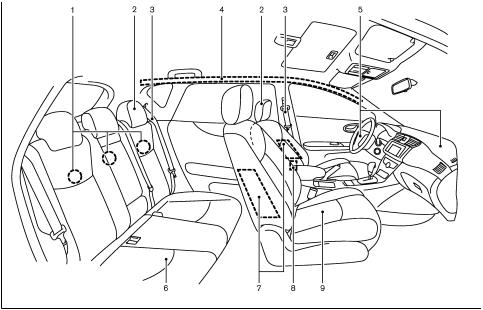
SEATS, SEAT BELTS AND
SUPPLEMENTAL RESTRAINT
SYSTEM (SRS)
GUID-6E6B3B80-EE26-4E5D-A367-35A9C11F30F7
|
|
|
JVC0433X |
1. |
Child restraint anchor points* (for top tether |
7. |
Supplemental side-impact air bags* (P.1-18) |
|
strap child restraint) (Page 1-12) |
8. |
Pre-tensioner seat belt system* (P.1-26) |
2. |
Head restraints (P.1-5) |
9. |
Front seats (P.1-2) |
3. |
Seat belts (P.1-7) |
*: |
if equipped |
4.Supplemental curtain side-impact air bags* (P.1-18)
5.Supplemental front-impact air bags (P.1-18)
6.Rear seats (P.1-3)
Ð Child restraints (P.1-12)
0-2 Illustrated table of contents

EXTERIOR FRONT
GUID-06F61144-5F27-4193-87C5-E0950EF9F755
10.Side turn signal lights (on the front fender or the outside rearview mirror)
ÐSwitch operation (P.2-19)
ÐBulb replacement (P.8-24)
11.Outside mirrors (P.3-18)
12.Doors
ÐKeys (P.3-2)
ÐDoor locks (P.3-3)
ÐIntelligent Key system* (P.3-7)
ÐRemote keyless entry system* (P.3-5)
ÐSecurity system* (P.3-14)
*: if equipped
JVC0429X
1.Engine hood (P.3-14)
2.Windshield wiper and washer
ÐSwitch operation (P.2-20)
ÐBlade replacement (P.8-15)
ÐWindow washer fluid (P.8-17)
3.Sunroof* (P.2-24)
4.Power windows (P.2-22)
5.Recovery hook (P.6-9)
6.Fog lights*
ÐSwitch operation (P.2-19)
ÐBulb replacement (P.8-24)
7.Headlight cleaners* (P.2-20)
8.Headlights and turn signal lights
ÐSwitch operation (P.2-17)
ÐBulb replacement (P.8-23)
9.Tires
ÐTires and wheels (P.8-31, P.9-7)
ÐFlat tire (P.6-2)
ÐTire placard (P.9-9)
Illustrated table of contents 0-3
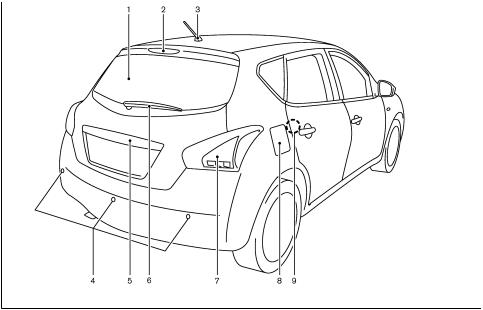
EXTERIOR REAR
GUID-E961F9FE-369F-49E4-9B87-99AC03634325
JVC0471X
1. |
Rear window defogger (P.2-21) |
|
Ð Window washer fluid (P.8-17) |
2. |
High-mounted stop light (P.8-24) |
7. |
Rear combination lights |
3. |
Antenna (P.4-18) |
|
Ð Switch operation (P.2-17) |
4. |
Sonar (parking sensor) system* (P.5-19) |
|
Ð Bulb replacement (P.8-24) |
5. |
Back door (P.3-15) |
8. |
Fuel filler lid |
|
Ð Intelligent Key system* (P.3-7) |
|
Ð Operation (P.3-17) |
|
Ð Remote keyless entry system* (P.3-5) |
|
Ð Fuel information (P.9-4) |
|
Ð Rearview camera* (P.4-2) |
9. |
Child safety rear door lock (P.3-5) |
6. |
Rear window wiper and washer |
*: |
if equipped |
|
Ð Switch operation (P.2-20) |
|
|
0-4 Illustrated table of contents
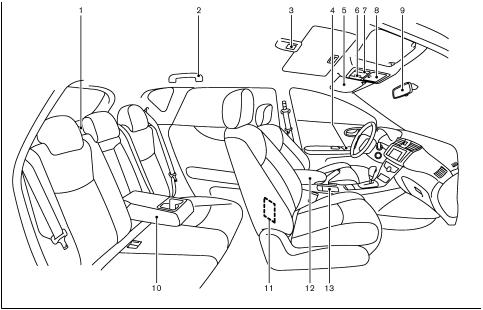
PASSENGER COMPARTMENT
GUID-A1CA6F24-0E68-4BA6-944C-91F3F2235BD3
13. Front cup holders (P.2-27) *: if equipped
JVC0477X
1.Cargo cover (P.2-28)
2.Coat hook* (P.2-28)
3.Room light (P.2-29)
4.Door armrest
ÐPower window switch (P.2-22)
ÐPower door lock switch (P.3-4)
5.Sun visors (P.2-29, P.3-19)
6.Sunroof switch* (P.2-24)
7.Map lights (P.2-30)
8.Sunglasses holder (P.2-27)
9.Inside rearview mirror (P.3-18)
10.Rear armrest* (P.1-4)
Ð Rear cup holders* (P.2-27)
11.Ashtray* (P.2-25)
12.Console box (P.2-26)
- Front armrest* (P.1-4)
- USB memory operation* (P.4-25) - iPod player operation* (P.4-26)
- USB/AUX connector* (P.4-28)
Illustrated table of contents 0-5
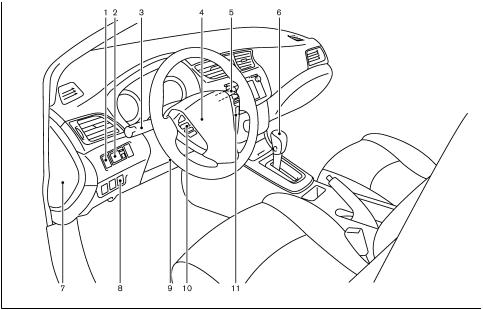
COCKPIT
GUID-4684994A-AD63-4E6A-8890-1C61156A3517
LEFT-HAND DRIVE (LHD) MODELS
GUID-9A3CAB91-CAE5-436A-BA48-04725A88B6A5
1.Instrument brightness control switch (P.2-7)
2.Outside rearview mirror control switch (P.3-18)
3.Headlight, fog light* and turn signal switch
ÐHeadlight (P.2-17)
ÐTurn signal (P.2-19)
ÐFog light* (P.2-19)
4.Steering wheel
ÐElectric power steering system (P.5-22)
0-6 Illustrated table of contents
JVC0480X
ÐHorn (P.2-22)
ÐDriver's supplemental front-impact air bag (P.1-18)
5.Wiper and washer switch (P.2-20)
6.Shift lever
ÐContinuously Variable Transmission (CVT) (P.5-9)
ÐManual Transmission (MT) (P.5-13)
7.Fuse box cover (P.8-22)
8.Vehicle Dynamic Control (VDC) OFF switch* (P.5-14)
9.Tilting/telescopic steering wheel lever (P.3-17)
10.Steering-wheel-mounted controls (left side)
Ð switch (odometer and trip computer) (P.2-10)
switch (odometer and trip computer) (P.2-10)
ÐAudio system* (P.4-28)
ÐBluetooth® Hands-Free Phone System (without navigation system)* (P.4-29)
ÐBluetooth® Hands-Free Phone System (with navigation system)**
11.Steering-wheel-mounted controls (right side)
ÐCruise control switches* (P.5-16)
*: if equipped
**: Refer to the separate NISSAN Connect Owner's Manual (if equipped).
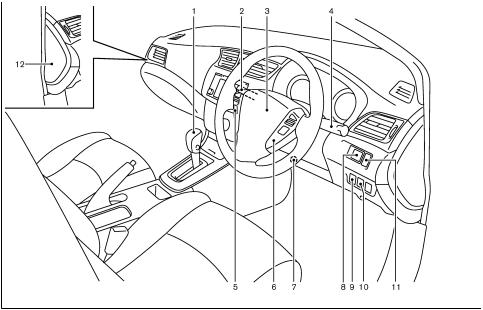
RIGHT-HAND DRIVE (RHD) MODELS
GUID-A5E7930B-0D66-42E4-BF05-07322329D1C5
JVC0437X
1.Shift lever
ÐContinuously Variable Transmission (CVT) (P.5-9)
ÐManual Transmission (MT) (P.5-13)
2.Wiper and washer switch (P.2-20)
3.Steering wheel
ÐElectric power steering system (P.5-22)
ÐHorn (P.2-22)
ÐDriver's supplemental front-impact air bag (P.1-18)
4.Headlight, fog light* and turn signal switch
ÐHeadlight (P.2-17)
ÐTurn signal (P.2-19)
ÐFog light* (P.2-19)
5.Steering-wheel-mounted controls (left side)
Ð switch (odometer and trip computer) (P.2-10)
switch (odometer and trip computer) (P.2-10)
ÐAudio system* (P.4-28)
ÐBluetooth® Hands-Free Phone System (without navigation system)* (P.4-29)
ÐBluetooth® Hands-Free Phone System (with navigation system)**
6.Steering-wheel-mounted controls (right side)
ÐCruise control switches* (P.5-16)
7.Tilting/telescopic steering wheel lever (P.3-17)
8.Outside rearview mirror control switch (P.3-18)
9.Vehicle Dynamic Control (VDC) OFF switch* (P.5-14)
10.Headlight aiming control switch* (P.2-18)
11.Instrument brightness control switch (P.2-7)
12.Fuse box cover (P.8-22)
*: if equipped
**: Refer to the separate NISSAN Connect Owner's Manual (if equipped).
Illustrated table of contents 0-7

INSTRUMENT PANEL
GUID-869B8C5C-FB2C-4E37-ACFC-D7D921E63756
LEFT-HAND DRIVE (LHD) MODELS
GUID-D95FEB79-F41E-4AA6-8EDC-C4DA4B58A0D0
JVC0307X
1.Meters and gauges (P.2-6)
2.Push-button ignition switch (models with Intelligent Key system) (P.5-5)
3.Center ventilator (P.4-5)
4.Hazard indicator flasher switch (P.6-2)
5.Audio system* (P.4-11) or Navigation system**
6.Passenger's front-impact air bag (P.1-18)
7.Side ventilator (P.4-5)
8.Fuel filler lid release handle (P.3-17)
9.Hood release handle (P.3-14)
10.Ignition switch (models without Intelligent Key system) (P.5-4)
11.Defogger switch (P.2-21)
12.Ashtray and cigarette lighter (P.2-25)
13.Parking brake (P.3-19, 8-12)
14.Heater and air conditioner control (P.4-6)
0-8 Illustrated table of contents
15. |
Glove box (P.2-26) |
*: |
if equipped |
**: |
Refer to the separate NISSAN Connect Owner's |
|
Manual (if equipped). |

RIGHT-HAND DRIVE (RHD) MODELS |
14. |
Hood release handle (P.3-14) |
GUID-D11B43F4-C0AA-4C9A-8A62-2E19D5DAC1AB |
15. |
Fuel filler lid release handle (P.3-17) |
|
*: |
if equipped |
|
**: |
Refer to the separate NISSAN Connect Owner's |
|
|
Manual (if equipped). |
JVC0306X
1.Side ventilator (P.4-5)
2.Passenger's front-impact air bag (P.1-18)
3.Audio system* (P.4-11) or Navigation system**
4.Hazard indicator flasher switch (P.6-2)
5.Center ventilator (P.4-5)
6.Push-button ignition switch (models with Intelligent Key system) (P.5-5)
7.Meters and gauges (P.2-6)
8.Glove box (P.2-26)
9.Heater and air conditioner control (P.4-6)
10.Parking brake (P.3-19, 8-12)
11.Power outlet* (P.2-25) or Ashtray and cigarette lighter* (P.2-25)
12.Defogger switch (P.2-21)
13.Ignition switch (models without Intelligent Key system) (P.5-4)
Illustrated table of contents 0-9
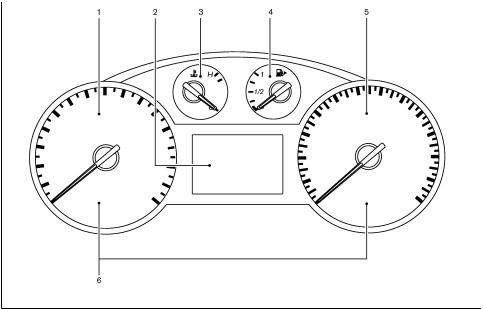
METERS AND GAUGES
GUID-088E5EE4-8597-421B-8873-FE92AA3F5ABE
JVI0275X
1. |
Tachometer (P.2-6) |
5. |
Speedometer (P.2-6) |
2. |
Vehicle information display (P.2-8) |
6. |
Warning/indicator lights (P.2-11) |
|
Ð Odometer/twin trip odometer (P.2-10) |
*: |
if equipped |
ÐOutside air temperature (P.2-8)
ÐContinuously Variable Transmission (CVT) position indicator* (P.2-8, P.5-9)
ÐTrip computer (P.2-8)
3.Engine coolant temperature gauge (P.2-7)
4.Fuel gauge (P.2-7)
0-10 Illustrated table of contents

ENGINE COMPARTMENT
GUID-43A12B5B-1EC5-4B57-AF49-1F11888695D0
MRA8DE ENGINE MODEL
GUID-6E1DA810-4A38-406B-8F9B-5641920A43EF
JVC0363X
1.Brake and clutch* fluid reservoir (P.8-13)
ÐRight-Hand Drive (RHD) models
2.Engine oil filler cap (P.8-9)
3.Brake fluid reservoir (P.8-13)
ÐLeft-Hand Drive (LHD) models
4.Air cleaner (P.8-15)
5.Battery (P.8-18)
ÐJump starting (P.6-5)
6.Window washer fluid reservoir (P.8-17)
7.Engine drive belt location (P.8-11)
8.Engine oil dipstick (P.8-9)
9.Radiator cap (P.8-7)
Ð Vehicle overheat (P.6-7)
10.Engine coolant reservoir (P.8-7)
11.Fuse/fusible link holders (P.8-21)
*: For Manual Transmission (MT) models
Illustrated table of contents 0-11
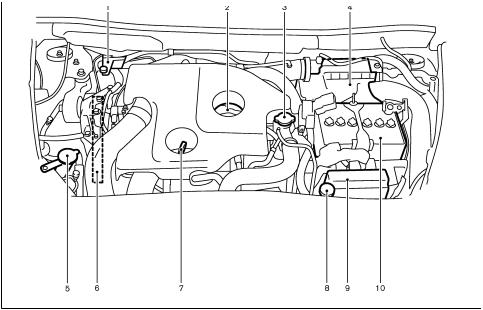
MR16DDT ENGINE MODEL
GUID-D8B2D2C0-7E46-4A8F-915F-A7C17E8386F2
JVM0262X
1. |
Brake and clutch* fluid reservoir (P.8-13) |
8. |
Engine coolant reservoir (P.8-7) |
2. |
Engine oil filler cap (P.8-9) |
9. |
Fuse/fusible link holders (P.8-21) |
3. |
Radiator cap (P.8-7) |
10. |
Battery (P.8-18) |
|
Ð Vehicle overheat (P.6-7) |
|
Ð Jump starting (P.6-5) |
4. |
Air cleaner (P.8-15) |
*: For Manual Transmission (MT) model |
|
5.Window washer fluid reservoir (P.8-17)
6.Engine drive belt location (P.8-11)
7.Engine oil dipstick (P.8-9)
0-12 Illustrated table of contents
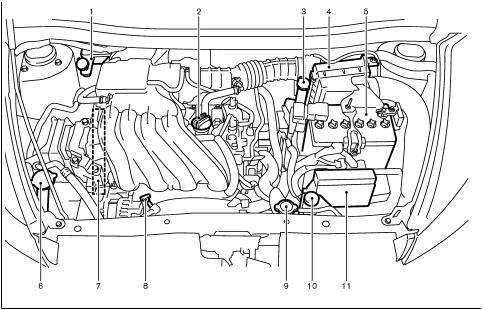
HR16DE ENGINE MODEL
GUID-DCE84F59-875A-4CF0-84D3-EDA6A831E16D
JVC0364X
1.Brake and clutch* fluid reservoir (P.8-13)
ÐRight-Hand Drive (RHD) models
2.Engine oil filler cap (P.8-9)
3.Brake and clutch* fluid reservoir (P.8-13)
ÐLeft-Hand Drive (LHD) models
4.Air cleaner (P.8-15)
5.Battery (P.8-18)
ÐJump starting (P.6-5)
6.Window washer fluid reservoir (P.8-17)
7.Engine drive belt location (P.8-11)
8.Engine oil dipstick (P.8-9)
9.Radiator cap (P.8-7)
Ð Vehicle overheat (P.6-7)
10.Engine coolant reservoir (P.8-7)
11.Fuse/fusible link holders (P.8-21)
*: For Manual Transmission (MT) models
Illustrated table of contents 0-13
MEMO
0-14 Illustrated table of contents

1 Safety Ð seats, seat belts and supplemental restraint system
Seats ........................................................................................................... |
1-2 |
Front seats .......................................................................................... |
1-2 |
Rear seats ........................................................................................... |
1-3 |
Armrest ................................................................................................ |
1-4 |
Head restraints ......................................................................................... |
1-5 |
Adjustable head restraint ................................................................ |
1-5 |
Non-adjustable head restraint ....................................................... |
1-5 |
Remove ................................................................................................ |
1-5 |
Install .................................................................................................... |
1-6 |
Adjust ................................................................................................... |
1-6 |
Seat belts .................................................................................................. |
1-7 |
Precautions on seat belt usage .................................................... |
1-7 |
Child safety ......................................................................................... |
1-8 |
Pregnant women ............................................................................... |
1-9 |
Injured persons .................................................................................. |
1-9 |
Center mark on seat belts .............................................................. |
1-9 |
Three-point type seat belts .......................................................... |
1-9 |
Two-point type seat belts (if equipped) ................................ |
1-11 |
Seat belt maintenance ............................................................... |
1-11 |
Child restraints ..................................................................................... |
1-12 |
Precautions on child restraint usage ...................................... |
1-12 |
Child restraint anchorage (if equipped) ................................ |
1-12 |
Child restraint installation using 3-point type seat belt |
|
(if equipped) ................................................................................. |
1-13 |
Child restraint installation using 2-point type seat belt |
|
(if equipped) ................................................................................. |
1-16 |
Supplemental Restraint System (SRS) .......................................... |
1-18 |
Precautions on Supplemental Restraint System (SRS) .... |
1-18 |
Supplemental air bag systems ................................................. |
1-22 |
SRS air bag deployment conditions ....................................... |
1-24 |
Pre-tensioner seat belt system (if equipped) ....................... |
1-26 |
Repair and replacement procedure ........................................ |
1-26 |
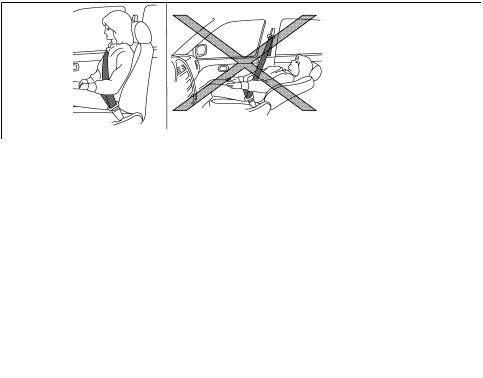
SEATS
GUID-65E1CF4D-248A-4E0E-B80E-0E67876FCCD6
WARNING:
.Do not drive and/or ride in the vehicle with the seatback reclined. This can be dangerous. The shoulder belt will not be properly against the body. In an accident, you and your passengers could be thrown into the shoulder belt and receive neck or other serious injuries. You and your passengers could also slide under the lap belt and receive serious injuries.
SSS0133A
FRONT SEATS |
|
GUID-EA19C552-8EF1-470D-8CB3-CAABA9F21446 |
|
WARNING: |
|
Do not adjust the driver seat while driving so |
' s |
that full attention may be given to vehicle |
|
operation. |
|
Manual seat adjustment |
|
GUID-E5A26E75-3DD6-4E76-AA24-3DBFA97F9F4B |
|
WARNING: |
|
.For the most effective protection while the vehicle is in motion, the seatback should be upright. Always sit well back in the seat and
adjust the seat belt properly. (See ª belts (P.1-7).) º
CAUTION:
After adjusting a seat, gently shake the seat to confirm that the seat is locked securely. If the seat is not locked securely, it may move
suddenly and could cause the loss of control of Seat
the vehicle.
When adjusting the seat positions, be sure not to contact any moving parts to avoid possible injuries and/or damages.
1-2 Safety Ð seats, seat belts and supplemental restraint system
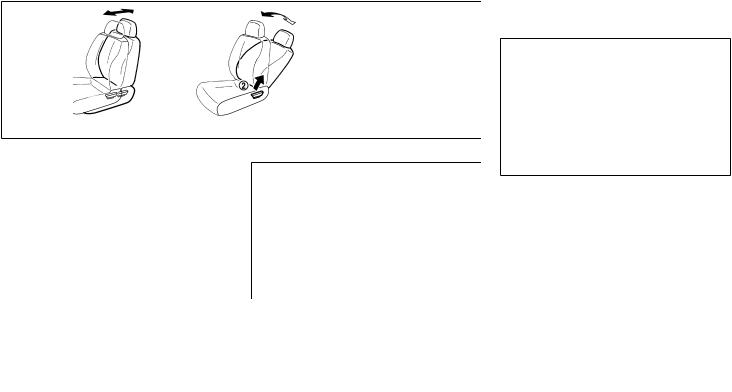
Forward and backward:
GUID-9E14C2E6-2E9C-4731-980B-C45B899B977B
1.Pull up the adjusting lever *1 .
2.Slide the seat to the desired position.
3.Release the adjusting lever to lock the seat in position.
Reclining:
GUID-9E14C2E6-2E9C-4731-980B-C45B899B977B
1.Pull up the adjusting lever *2 .
2.Tilt the seatback to the desired position.
3.Release the adjusting lever to lock the seatback in position.
The reclining feature allows the adjustment of the seatback for occupants of different sizes to help obtain the proper seat belt fit. (See ªSeat beltsº (P.1-7).)
The seatback may be reclined to allow occupants to rest when the vehicle is parked.
SSS0792
Seat lifter (if equipped):
GUID-9E14C2E6-2E9C-4731-980B-C45B899B977B
SSS1129
Pull up or push down the adjusting lever to adjust the seat height until the desired position is achieved.
REAR SEATS
GUID-A95A1654-09D4-44BC-89C1-C253B6CC3D14
Folding
GUID-1776AFB3-BD79-41D2-B498-D7CAC47A8A6B
SSS1145
Before folding the rear seats:
GUID-9E14C2E6-2E9C-4731-980B-C45B899B977B
Secure the seat belts on the seat belt hooks on the side wall. (See ªSeat belt hooksº (P.1-10).)
To fold the seatback, pull the adjusting knob *1 .
To return the seatback to the seating position, lift up each seatback and push it to the upright position until it is latched.
CAUTION:
When folding or returning the seatback(s) to the upright position, make sure that the seat path is clear before moving the seat to avoid injury to yourself and others.
WARNING:
.Never allow anyone to ride in the luggage area or on the rear seats when they are in the fold-down position. Use of these areas by passengers without proper restraints could result in serious injury in an accident
Safety Ð seats, seat belts and supplemental restraint system 1-3
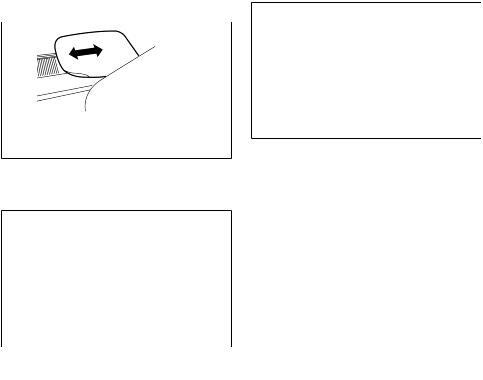
or sudden stop.
.Do not fold down the rear seats when occupants are in the rear seat area or any luggage is on the rear seats.
.Properly secure all luggage to help prevent it from sliding or shifting. Do not place luggage higher than the seatbacks.
.When returning the seatbacks to the upright position, be certain they are completely secured in the latched position. If they are not completely secured, passengers may be injured in an accident or sudden stop.
.Head restraints should be adjusted properly as they may provide significant protection against whiplash injury. Always replace and adjust them properly if they have been removed for any reason.
ARMREST |
Rear (if equipped) |
GUID-403C964A-AB99-4CBE-97C9-20E36AA8A07E |
GUID-98AB7A5D-36C0-4EF1-B4E6-CE0EC7D788CB |
Front |
|
GUID-116F0D1F-2BF9-4B1A-AEC8-6A38242B8071 |
|
SIC4593
JVR0118X Pull the armrest forward until it is horizontal.
To use the front armrest, slide it forward.
Slide the armrest to the original position when using the front cup holders.
JVR0042X
CAUTION:
When the front armrest is in the forward-most position, do not place your fingers on the bottom portion of the armrest to avoid possible injuries. Your fingers could be injured if the armrest slides to its original position.
1-4 Safety Ð seats, seat belts and supplemental restraint system
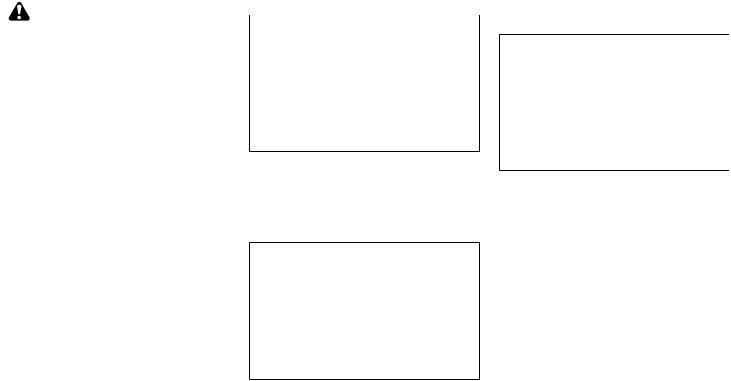
HEAD RESTRAINTS
GUID-1D2DB560-F0D1-4E17-A618-221460107213
WARNING:
Head restraints supplement the other vehicle safety systems. They may provide additional protection against injury in certain rear end collisions. Adjustable head restraints must be adjusted properly, as specified in this section. Check the adjustment after someone else uses the seat. Do not attach anything to the head restraint stalks or remove the head restraint. Do not use the seat if the head restraint has been removed. If the head restraint was removed, reinstall and properly adjust the head restraint before an occupant uses the seating position. Failure to follow these instructions can reduce the effectiveness of the head restraint. This may increase the risk of serious injury or death in a collision.
.Your vehicle is equipped with a head restraint that may be integrated, adjustable or non-adjustable.
.Adjustable head restraints have multiple notches along the stalk to lock them in a desired adjustment position.
.The non-adjustable head restraints have a single locking notch to secure them to the seat frame.
.Proper Adjustment:
ÐFor the adjustable type, align the head restraint so the center of your ear is approximately level with the center of the head restraint.
ÐIf your ear position is still higher than the recommended alignment, place the head restraint at the highest position.
.If the head restraint has been removed, ensure that it is reinstalled and locked in place before riding in that designated seating position.
ADJUSTABLE HEAD RESTRAINT
GUID-6C88D4AC-5493-4D7E-A8B2-5C0BA789C719
SSS0992
1.Removable head restraint
2.Multiple notches
3.Lock knob
4.Stalks
NON-ADJUSTABLE HEAD RESTRAINT
GUID-1EB1A16B-94AC-4529-82EA-BEC9EB4F3D4A
JVR0203X
1.Removable head restraint
2.Single notch
3.Lock knob
4.Stalks
REMOVE
GUID-290925FB-6436-4FF1-9E3D-7ED53BDC5322
SSS1037
Use the following procedure to remove the head restraint.
1.Pull the head restraint up to the highest position.
2.Push and hold the lock knob.
3.Remove the head restraint from the seat.
4.Store the head restraint properly in a secure place so it is not loose in the vehicle.
5.Reinstall and properly adjust the head restraint before an occupant uses the seating position.
Safety Ð seats, seat belts and supplemental restraint system 1-5

INSTALL
GUID-73A81482-05DF-4DF7-B2C4-2E27EA6245FD
SSS1038
1.Align the head restraint stalks with the holes in the seat. Make sure that the head restraint is facing
the correct direction. The stalk with the adjustment
notch *1 must be installed in the hole with the lock knob *2 .
2.Push and hold the lock knob and push the head restraint down.
3.Properly adjust the head restraint before an occupant uses the seating position.
ADJUST
GUID-9E1F43B9-8B6D-4575-9B2E-4EFB399EE3DA
For adjustable head restraint
Adjust the head restraint so the center is level with the center of your ears. If your ear position is still higher than the recommended alignment, place the head restraint at the highest position.
JVR0259X
For non-adjustable head restraint
Make sure the head restraint is positioned from the stored position or any non-latch position so the lock knob is engaged in the notch before riding in that designated seating position.
Raise
GUID-381E3681-A0D7-4BA9-99AB-F3036FA3C573
SSS0997 |
SSS1035 |
To raise the head restraint, pull it up.
1-6 Safety Ð seats, seat belts and supplemental restraint system
Make sure the head restraint is positioned from the stored position or any non-latch position so the lock knob is engaged in the notch before riding in that designated seating position.
Lower
GUID-7009499C-CED8-4CB8-99B7-1F53EBF13F41
SSS1036
To lower, push and hold the lock knob and push the head restraint down.
Make sure the head restraint is positioned so the lock knob is engaged in the notch before riding in that designated seating position.
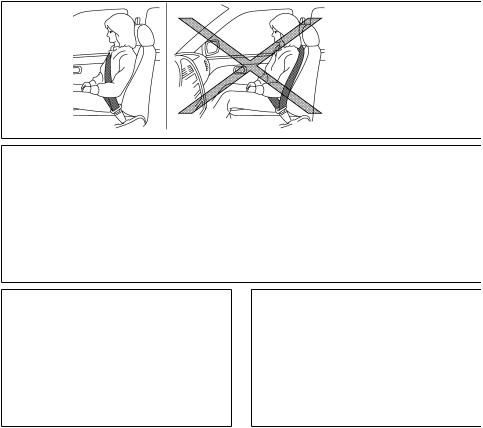
SEAT BELTS
GUID-B24797EF-9596-4C08-A632-05BD45FC2BE9
PRECAUTIONS ON SEAT BELT USAGE
GUID-7E5A0FD7-D295-4EFD-A08C-C72A17D14624
If you are wearing the seat belt properly adjusted and sitting upright and well back in the seat, chances of being injured or killed in an accident and/or the severity of injury may be greatly reduced. NISSAN strongly encourages you and all of your passengers to buckle up every time you drive, even if your seating position includes the supplemental air bag systems.
SSS0134A
SSS0136A
SSS0014 |
SSS0016 |
Safety Ð seats, seat belts and supplemental restraint system 1-7

WARNING:
.Seatbelts are designed to bear upon the bony structure of the body, and should be worn low across the front of the pelvis or the pelvis, chest and shoulders, as applicable; wearing the lap section of the belt across the abdominal area must be avoided. Serious injury may occur if a seat belt is not worn properly.
.Position the lap belt as low and snug as possible around the hips, not the waist. A lap belt worn too high could increase the risk of internal injuries in an accident.
.Do not allow more than one person to use the same seat belt. Each belt assembly must only be used by one occupant; it is danger-
ous to put a belt around a child being carried on the occupant lap.
.Never carry more people in the vehicle than there are seat belts.
.Never wear seat belts inside out. Belts should not be worn with straps twisted. Doing so may reduce their effectiveness.
.Seatbelts should be adjusted as firmly as possible, consistent with comfort, to provide the protection for which they have been designed. A slack belt will greatly reduce the protection afforded to the wearer.
.Every person who drives or rides in this vehicle should use a seat belt at all times. Children should be properly restrained in the rear seat and, if appropriate, in a child restraint system.
.Do not run the belt behind your back or under your arm. Always route the shoulder belt over your shoulder and across your chest. The belt should be away from your face and neck, but not falling off your shoulder. Serious injury may occur if a seat belt is not worn properly.
.No modifications or additions should be made by the user which will either prevent the seat belt adjusting devices from operating to remove slack, or prevent the seat belt assembly from being adjusted to remove slack.
.Care should be taken to avoid contamination of the webbing with polishes, oils and chemicals, and particularly battery acid. Cleaning may safely be carried out using mild soap and water. The belt should be replaced if webbing becomes' frayed, contaminated or damaged.
.All seat belt assemblies including retractors and attaching hardware should be inspected after any collision by a NISSAN dealer. NISSAN recommends that all seat belt assemblies in use during a collision be replaced unless the collision was minor and the belts show no damage and continue to operate properly. Seat belt assemblies not in use during a collision should also be inspected and, when necessary, replaced if either damage or improper operation is noted.
.It is essential to replace the entire assembly after it has been worn in a severe impact even if damage to the assembly is not obvious.
.Once the pre-tensioner seat belt (if equipped) has activated, it cannot be reused. It must be replaced together with the retractor. Contact a NISSAN dealer.
.Removal and installation of the pre-ten- sioner seat belt system components (if equipped) should be done by a NISSAN dealer.
CHILD SAFETY
GUID-50FE0FCD-DBC6-4BF8-A13A-E3AFA74EB719
WARNING:
.Infants and children need special protection.
The vehicle seat belts may not fit them properly. The shoulder belt may come too close to the face or neck. The lap belt may not fit over their small hipbones. In an accident, an improperly fitted seat belt could cause serious or fatal injury.
.Always use an appropriate child restraint system.
Children need adults to help protect them. They need to be properly restrained. The proper restraint depends on the child's size.
1-8 Safety Ð seats, seat belts and supplemental restraint system
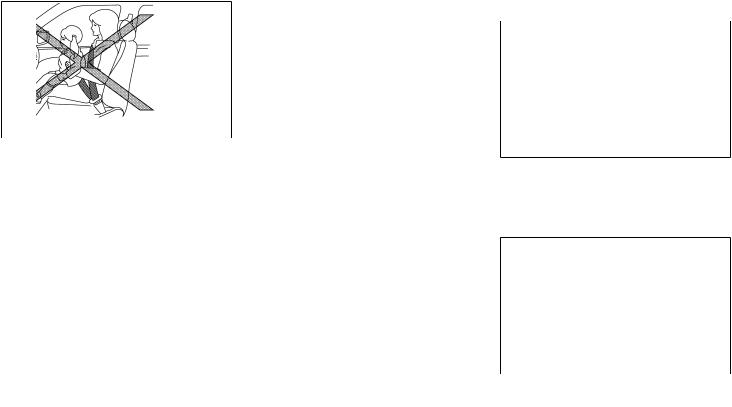
Infants and small children
GUID-9EA9FF02-4615-4E08-8998-8897493078B8
SSS0099
NISSAN recommends that infants and small children be seated in a child restraint system. You should choose a child restraint system that fits your vehicle and the child, and always follow the manufacturer's instructions for installation and use.
Large children
GUID-7EC09A67-00D1-4A31-9107-8BC52BC8A5CE
WARNING:
.Never allow children to stand or kneel on any seats.
.Never allow children in the cargo areas while the vehicle is moving. A child could be seriously injured in an accident or sudden stop.
Children who are too large for a child restraint system should be seated and restrained by the seat belts that are provided.
If the child's seating position has a shoulder belt that fits close to the face or neck, the use of a booster seat (commercially available) may help overcome this. The booster seat should raise the child so that the shoulder belt is properly positioned across the top, middle
portion of the shoulder and the lap belt is low on the hips. The booster seat should also fit the vehicle seat. Once the child has grown so that the shoulder belt is no longer on or near the face or neck of the child, use the shoulder belt without the booster seat. In addition, there are many types of child restraint systems available for larger children that should be used for maximum protection.
PREGNANT WOMEN
GUID-EB362D86-544D-4564-AF14-2AA962BFFC63
NISSAN recommends that pregnant women use seat belts. The seat belt should be worn snug, and always position the lap belt as low as possible around the hips, not the waist. Place the shoulder belt over your shoulder and across your chest. Never run the lap/ shoulder belt over your abdominal area. Contact your doctor for specific recommendations.
INJURED PERSONS
GUID-11687DB4-061D-4F49-9F66-C8C24C9C8A28
NISSAN recommends that injured persons use seat belts. Contact your doctor for specific recommendations.
CENTER MARK ON SEAT BELTS
GUID-4379FCB6-A0FC-49F8-B357-9DDABA29EF87
Selecting correct set of seat belts
GUID-D44FE812-A107-4F66-B3D5-9588A17259FA
JVR0041X
The center seat belt buckle and the tongue are identified by the CENTER mark. The center seat belt tongue can be fastened only into the center seat belt buckle.
THREE-POINT TYPE SEAT BELTS
GUID-0BC1986B-C5D8-4503-B446-845D468C8DFE
SSS0292
WARNING:
Every person who drives or rides in this vehicle should use a seat belt at all times.
Safety Ð seats, seat belts and supplemental restraint system 1-9
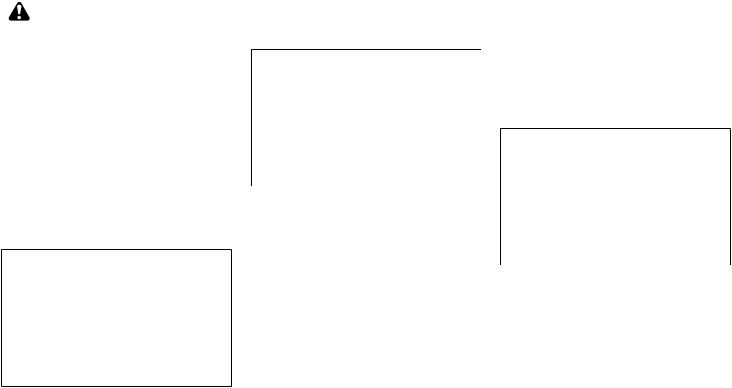
Fastening seat belts |
4. |
Pull the shoulder belt portion toward the retractor |
|
|
|
||
GUID-89F085F0-308A-481D-A480-9ED347F5EEA1 |
|
to take up extra slack. Be sure the shoulder belt is |
|
|
|
||
WARNING: |
|
routed over your shoulder and is snug across your |
|
|
chest. |
||
|
|
||
The seatback should not be in a reclined |
Shoulder belt height adjustment (front seats) |
||
position any more than needed for comfort. Seat |
|||
|
GUID-3C34CDBB-BB30-4CBB-99BE-2387B7C1E699 |
||
belts are most effective when the passenger sits |
|
|
|
well back and straight up in the seat. |
|
|
|
1. Adjust the seat. (See ªSeatsº (P.1-2).) |
|
|
|
2. Slowly pull the seat belt out of the retractor and |
|
|
|
insert the tongue into the buckle until you hear and |
|
|
|
feel the latch engage. |
|
|
|
. The retractor is designed to lock during a |
|
|
|
sudden stop or on impact. A slow pulling |
|
|
|
motion permits the seat belt to move, and |
|
|
|
allows you some freedom of movement in |
|
SSS0351A |
|
|
|
||
the seat. |
|
|
|
. If the seat belt cannot be pulled from its |
|
WARNING: |
|
fully retracted position, firmly pull the belt |
|
||
|
|
||
and release it. Then smoothly pull the belt |
. |
The shoulder belt anchor height should be |
|
out of the retractor. |
|
adjusted to the position best for you. Failure |
|
|
|
to do so may reduce the effectiveness of the |
|
|
|
entire restraint system and increase the |
|
|
|
chance or severity of injury in an accident. |
|
|
. |
The shoulder belt should rest on the middle |
|
|
|
of the shoulder. It must not rest against the |
|
|
|
neck. |
|
|
. |
Be sure that the seat belt is not twisted in |
|
|
|
any way. |
|
|
. |
Be sure that the shoulder belt anchor is |
|
|
|
secured by trying to move the shoulder belt |
|
SSS0467 |
|
anchor up and down after adjustment. |
|
3. Position the lap belt portion low and snug on the |
The shoulder belt anchor height should be adjusted to |
||
hips as shown. |
the position best for you. |
||
The belt should be away from your face and neck, but
1-10 Safety Ð seats, seat belts and supplemental restraint system
not falling off your shoulder.
To adjust, pull the release button *1 and move the shoulder belt anchor to the proper position *2 , so that the belt passes over the center of the shoulder.
Release the button to lock the shoulder belt anchor into position.
Unfastening seat belts
GUID-B9FD6826-2EEF-4B6A-BBB2-8DA9DC9A114C
Push the button on the buckle. The seat belt automatically retracts.
Seat belt hooks
GUID-0A7B1C10-9CFD-4887-B9D3-AF0EDDB1D238
SSS1138
When the rear seat belts are not in use and when folding down the rear seats, hook the rear outer seat belts on the seat belt hooks.
Checking seat belt operation
GUID-403EE7BD-2595-4C9C-B3EC-2256E3EF91C8
Seat belt retractors are designed to lock seat belt movement:
.When the seat belt is pulled quickly from the retractor.
.When the vehicle slows down rapidly.
To increase your confidence in the seat belts, check the operation by grasping the shoulder belt and pulling forward quickly. The retractor should lock and restrict
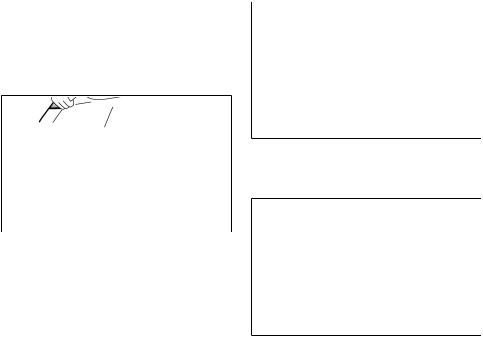
further belt movement. If the retractor does not lock during this check, contact a NISSAN dealer immediately.
TWO-POINT TYPE SEAT BELTS (if equipped)
Fastening seat belts
GUID-4E3A86C9-2C5C-4948-B0A8-7998841C1CDE
JVR0035X
WARNING:
Seat belts are most effective when the passenger sits well back and straight up in the seat.
1.Insert the tongue into the buckle marked CENTER until you hear and feel the latch engage.
JVR0036X
2.Adjust the seat belt length. To shorten, hold the tongue and pull the upper belt as illustrated *1 . To lengthen, hold the tongue and pull the under belt as illustrated *2 .
JVR0037X
3.Position the lap belt portion low and snug on the hips as shown.
Unfastening seat belts
GUID-B678EAF0-A08C-4DF6-BC72-45BFD830E250
Push the button on the buckle.
SEAT BELT MAINTENANCE
GUID-1C0BBCBB-C6A2-4E79-BD2C-4BF0F58A6E61
Periodically check that the seat belt and all the metal components, such as buckles, tongues, retractors, flexible wires and anchors, work properly. If loose parts, deterioration, cuts or other damage on the seat belt webbing is found, the entire seat belt assembly should be replaced.
If dirt builds up in the shoulder belt guide of the seat belt anchors, the seat belts may retract slowly. Wipe the shoulder belt guide with a clean, dry cloth.
To clean the seat belt webbing, apply a mild soap solution or any solution recommended for cleaning upholstery or carpet. Then wipe with a cloth and allow the seat belts to dry in the shade. Do not allow the seat belts to retract until they are completely dry.
Safety Ð seats, seat belts and supplemental restraint system 1-11
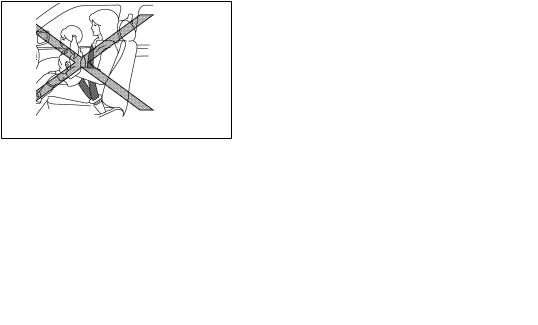
CHILD RESTRAINTS
GUID-F2068D73-379A-46BC-9200-AB7FD98E9DCB
PRECAUTIONS ON CHILD RESTRAINT
USAGE
GUID-843A7C9C-1266-4B11-9B92-C7AD768A370E
SSS0099
WARNING:
.Infants and small children should always be placed in an appropriate child restraint while riding in the vehicle. Failure to use a child restraint can result in serious injury or death.
.Infants and small children should never be carried on your lap. It is not possible for even the strongest adult to resist the forces of a severe accident. The child could be crushed between the adult and parts of the vehicle. Also, do not put the same seat belt around both your child and yourself.
.NISSAN recommends that the child restraints be installed in the rear seat. According to accident statistics, children are safer when properly restrained in the rear seat than in the front seat.
.Improper use or improper installation of a child restraint can increase the risk or severity of injury for both the child and other occupants of the vehicle and can lead to
serious injury or death in an accident.
.Follow all of the child restraint manufac-
turer instructions for installation and' suse.
When purchasing a child restraint, be sure to select one which will fit your child and vehicle. It may not be possible to properly install some types of child restraint in your vehicle.
.The direction of the child restraint, either front-facing or rear-facing, depends on the
type of the child restraint and the size of the child. Refer to the child restraint manufacturer instructions for details. ' s
.Adjustable seatbacks should be positioned to fit the child restraint, but as upright as possible.
.After attaching a child restraint, test it before you place the child in it. Push it from side to side and tug it forward to make sure that it is held securely in place. The child restraint should not move more than 25 mm (1 in). If the restraint is not secure, tighten the belt as necessary, or install the restraint in another seat and test it again.
.When the child restraint is not in use, keep it secured with a seat belt to prevent it from being thrown around in case of a sudden stop or accident.
.Never install a rear-facing child restraint on
the front passenger seat when the front passenger air bag is available. Supplemental front-impact air bags inflate with great force. A rear-facing child restraint could be struck by the supplemental frontimpact air bags in an accident and could seriously injure or kill your child.
1-12 Safety Ð seats, seat belts and supplemental restraint system
.If the seat belt in the position where a child restraint is installed requires a locking device and if it is not used, injuries could result from a child restraint tipping over during normal vehicle braking or cornering.
CAUTION:
Remember that a child restraint left in a closed vehicle can become very hot. Check the seating surface and buckles before placing your child in a child restraint.
NISSAN recommends that infants and small children be seated in a child restraint. You should choose a child restraint that fits your vehicle and always follow the manufacturer's instructions for installation and use. In addition, there are many types of child restraints available for larger children that should be used for maximum protection.
CHILD RESTRAINT ANCHORAGE (if
equipped)
GUID-999EF414-BA0B-4E48-86C4-F6A14C27D2DC
Your vehicle is designed to accommodate a child restraint system on the rear seat. When installing a child restraint system, carefully read and follow the instructions in this manual and those supplied with the child restraint system.
WARNING:
.Child restraint anchorages are designed to
withstand only |
' s |
by |
those loads imposed |
||
correctly fitted |
' s |
no |
child restraints. Under |
circumstances are they to be used for adult seat belts, harnesses or for attaching other items or equipment to the vehicle. Doing so could damage the child restraint anchorages. The child restraint will not be
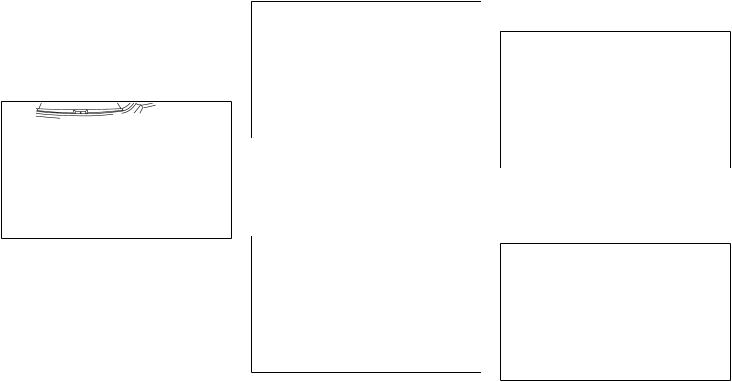
properly installed using the damaged anchorage, and a child could be seriously injured or killed in a collision.
.The child restraint top tether strap may be damaged by contact with the cargo cover or items in the luggage area. Remove the cargo cover from the vehicle or secure it and any luggage. Your child could be seriously injured or killed in a collision if the top tether strap is damaged.
Anchorage location
GUID-10B2BB22-866D-4899-AF59-A4697DD460CB
JVR0194X
The anchor points are located on the back side of the rear seatbacks.
CHILD RESTRAINT INSTALLATION USING
3-POINT TYPE SEAT BELT (if equipped)
GUID-88B65913-C497-4813-85DA-387E04EA1320
Installation on rear outer seats
GUID-BD49434F-1329-4217-B13F-291E826C3ED4
SSS0758A
Step 1
Front-facing:
GUID-9E14C2E6-2E9C-4731-980B-C45B899B977B
Be sure to follow the manufacturer's instructions for the proper use of your child restraint. Follow these steps to install a front-facing child restraint on the rear seats using 3-point type seat belt:
1.Position the child restraint on the seat *1 .
SSS0493A
Step 2
2.Route the seat belt tongue through the child restraint and insert it into the buckle *2 until you hear and feel the latch engage.
3.To prevent slack in the seat belt webbing, it is necessary to secure the seat belt in place with locking devices attached to the child restraint.
SSS0647A
Step 4
4.Remove any additional slack from the seat belt; press downward *3 and rearward *4 firmly in the center of the child restraint with your knee to compress the vehicle seat cushion and seatback while pulling up on the seat belt.
SSS0638A
Step 5
Safety Ð seats, seat belts and supplemental restraint system 1-13
